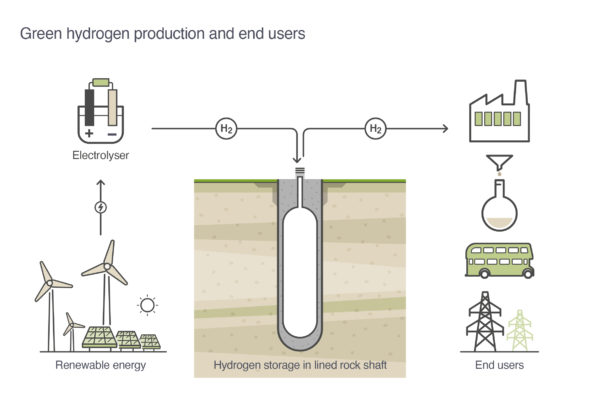Gravitricity, a Scottish energy storage specialist, has signed a memorandum of understanding with structural engineering contractor VSL Systems UK to develop its first full-scale demonstration project in the United Kingdom for the underground storage of hydrogen. The company told pv magazine that initial use cases for its purpose-built storage systems will include industrial uses and heavy transport, so the systems will likely be located at industrial sites.
Gravitricity’s FlexiStore technology can store up to 1,000 tons of compressed gaseous hydrogen per shaft, and multiple shafts can be co-located at a single site. Current salt mine storage solutions do not provide for flexibility of location, but the FlexiStore system can be installed close to renewable energy facilities, where green hydrogen storage can also help to provide grid-balancing services.
“A single FlexiStore would store the green hydrogen generated by a 460 MW offshore wind farm and could be emptied and refilled daily,” the company said in a statement, noting that multiple shafts “could soak up vast amounts of otherwise wasted or ‘constrained’ wind – which amounted to 3.6 TWh in 2020.”
Gravitricity said its underground steel-lined rock shafts will be safer than current above-ground storage technologies, which have a higher risk of damage and leaks. Under the terms of the deal, VSL Systems UK will contribute its expertise to the design and construction of the FlexiStore structures, which will be 6 meters in diameter and 365 meters deep, with a capacity of 100 tons of gaseous hydrogen at 220 bar. Gravitricity estimates that the daily storage capacity could be sufficient to refuel more than 1000 HGVS, or to power 500 buses for a week.
A Gravitricity spokesperson told pv magazine that FlexiStore systems will eventually also tap into the potential of gravitational energy, as heavy weights (up to 12,000 tons) are dropped through the hydrogen stored in the shaft. The company is in advanced discussions with Bendalls Engineering to fabricate the linings for the rock shafts, and it is seeking funds for the UK demonstration project.
The company’s gravity-based storage technology is currently being demonstrated in existing mine shafts in Czechia. The technology purportedly has a faster response time than lithium-ion storage technology and can help to stabilize electricity networks at 50 Hz by responding to full power demand in less than a second.

This content is protected by copyright and may not be reused. If you want to cooperate with us and would like to reuse some of our content, please contact: editors@pv-magazine.com.




2 comments
By submitting this form you agree to pv magazine using your data for the purposes of publishing your comment.
Your personal data will only be disclosed or otherwise transmitted to third parties for the purposes of spam filtering or if this is necessary for technical maintenance of the website. Any other transfer to third parties will not take place unless this is justified on the basis of applicable data protection regulations or if pv magazine is legally obliged to do so.
You may revoke this consent at any time with effect for the future, in which case your personal data will be deleted immediately. Otherwise, your data will be deleted if pv magazine has processed your request or the purpose of data storage is fulfilled.
Further information on data privacy can be found in our Data Protection Policy.